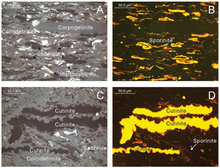Maceral

Macerals or macerals are the organic rock-forming components of coals and kerogens . Thus they have a similar function as the minerals as basic components of rocks and consist mostly of plant residues, the overlapping under pressure from rock deposits, due to the increased temperature and the working fluid phase chemical were converted ( diagenesis or at higher pressures and temperatures metamorphism ). Three groups of maceral are distinguished:
- Vitrinites are the main component of humus coals. They arise from the humification of woody material, are dark brown to black in their own right, opaque in the transmitted light microscope , and show an increasing gloss with a high degree of carbonization (from hard brown coal ).
- Inertinites are non-flammable macerals that arise from already burned plant tissue and ash (in the case of resinites and fusinites , similar to charcoal from coal kilns, the characteristic cell structure can still be recognized under the microscope, e.g. from polymerized plant resins or Mushroom residues).
- Exinites (or Liptinites ) are lipid-rich macerals that are transparent in the transmitted light microscope and yellow to red in the fluorescence microscope , which result from the diagenesis of natural resins , waxes , spores and pollen as well as algae bodies .
In the case of coal , the macroscopic appearance (the type of stripes ) varies depending on the proportion of the individual macerals:
- Vitrite ( luster charcoal) describes a humus charcoal rich in vitrinite
- Durit ( matt coal ) is a hard, but only matt, liptinite-rich humus coal.
- Clarit ( semi-gloss charcoal ) mediates between the two types, e.g. B. alternate between glossy and matte layers at close intervals.
- Fusit ( fiber charcoal ) is softer, consists to a large extent of fusinite and turns black when touched. Presumably it is a product of forest fires.
In the course of increasing coalification , the different types of stripes become more and more similar through vitrinization. The coal is getting harder and shinier. Hence, in petrography, vitrinite reflectance is a parameter that indicates the degree of ripeness of coals and other rocks containing organic carbon.
literature
A. Hutton, S. Bharati & T. Robl: Chemical and petrographic classification of kerogen / macerals. In: Energy & Fuels , 8 (6), 1994, pp. 1478-1488 doi : 10.1021 / ef00048a038
Web links
- Identification of Coal Components. University of Kentucky